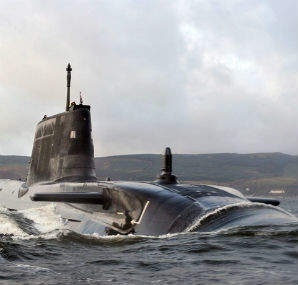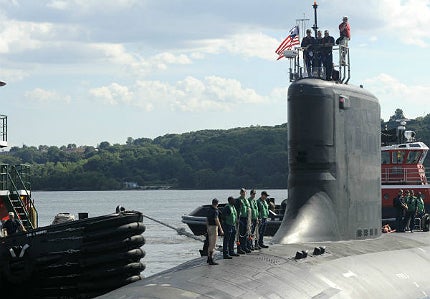

In December 2006, the UK Government under Prime Minister Tony Blair confirmed it would maintain the UK’s independent nuclear deterrent beyond 2020 by replacing the Royal Navy’s existing Vanguard-Class nuclear-powered ballistic missile submarines (SSBNs) – HMS Vanguard, HMS Vengeance, HMS Victorious and HMS Vigilant – with three or four next-generation Successor submarines at an estimated cost of £11-14bn.
Four years and two Prime Ministers later in May 2011, the upgrade programme entered the Initial Assessment phase. The following year, UK Defence Secretary Philip Hammond announced that contracts worth £350m had been awarded to three UK companies to commence detailed design work on the Successor SSBNs.
The largest contract to date, worth £800m, was awarded in February of this year to Rolls-Royce, which will design a new nuclear propulsion system for the Successor and Astute-Class submarines, as well as being responsible for the integration of the reactor design.
By consolidating costs into one agreement as part of the UK Government’s submarine enterprise performance programme (SEPP), the UK Ministry of Defence (MoD) and Rolls-Royce expect to make savings of around £200m in the next decade.
BAE Systems Maritime – Submarines will be paid £328m to work on the overall submarine design, while Babcock will focus on devising parts of the in-service support as part of £15m agreement. Contracts with both companies to deliver further savings are expected in due course.
A final design and build decision will be made at the Main Gate investment point in 2016, after which the main construction contracts will be signed. The first Successor submarine is due to be delivered in 2028, replacing the Vanguard-Class submarines at the end of their service life.
Astute design: Concept 35 and Advanced Hull Forms
With total out-turn costs estimated at as much as £25m, designing an all-new submarine to replace the Vanguard-Class vessels was dismissed as too expensive. Instead, the Successor submarines are likely to draw heavily from proven Astute-Class design innovations and technologies.
According to the Navy Matters website, BAE Systems Maritime – Submarines has already examined two variants fitted with an extra hull section. The first includes fitting 16 Mark 36 Vertical Launch System tubes – suitable for missiles such as the Tomahawk – externally to the pressure hull.
The second, preferred option involves the installation behind the fin of four Trident II-size missile tubes measuring 86in in diameter and 36ft in length. These large, versatile tubes could potentially carry a next-generation ballistic missile, a multiple all-up round canister accommodating seven Tomahawk cruise missiles per tube, special forces equipment and vehicles, unmanned underwater vehicles (UUVs), deployable decoys and sensors and encapsulated unmanned air vehicles (UAVs).
BAE Submarine Solutions also unveiled two new design concepts under development for the MoD’s Future Submarine project, which may inform the design of the Successor-Class submarines.
Evolved from the Vanguard-Class and based on a submarine design philosophy that aims to reduce cost of ownership throughout the whole vessel lifecycle, Concept 35 focuses on simplifying submarine assembly, removing the need for extensive dockyard modernisation and reducing the number of piece parts and bespoke submarine systems.
The concept also includes a next-generation Naval Propulsion Plant, with extensive passive features and designed for disposal; extensive use of automation for submarine control, damage control and condition monitoring; full electric propulsion with shaftless drive; externally mounted tactical weapons; electrical actuation of control surfaces; and replacement of obsolete technologies with military and commercial off-the-shelf equipment.
The Advanced Hull Form submarine concept uses modular design techniques and advanced hydrodynamics to create an unorthodox external hull form, which offers enhanced signatures, manoeuvring and safety, and large volumes for payloads and equipment outside the pressure hull. This gives exceptional flexibility in design and operation, with the maximum opportunity for rapid role change or upgrading.
Safety is enhanced by the hydrodynamic design, which offers improved manoeuvring and emergency recovery compared with current designs. It is further improved through the external payload and equipment locations, which minimise hull penetrations and improve watertight integrity.
The Advanced Hull Form has been designed for low-cost fabrication using largely flat or single curvature surfaces. This approach also allows rapid repair and modification, giving the basis for a flexible, economical and resilient platform.
Power surge: PWR-3 propulsion, munitions and electrical systems
A salient feature of the Successor-Class programme has been collaboration between the UK MoD and experts from the US on a new £3bn PWR-3 pressurised water reactor nuclear power plant.
The third generation of UK-designed and built submarine pressurised water reactors, PWR-3 builds on leading-edge nuclear propulsion plant (NGNPP) research undertaken by the MoD and Rolls-Royce in the last decade. Design is at an advanced level, component-level modelling and testing is underway and some initial prototyping of critical hardware is already complete.
Although the exact nature of the UK’s access to US Navy reactor technology remain a secret, the Royal Institution of Naval Architects (RINA) reports it is likely that the UK MoD has been given visibility of the S9G reactor design that equips the US Navy’s latest Virginia-Class nuclear-powered attack submarines (SSNs).
Submarines with the PWR-3 system are around £50m more expensive to buy and operate compared with PWR-2-powered vessels over a 25-year lifespan. However, PWR-3 technology offers superior performance, is easier to operate, provides a longer in-service life and reduced through-life maintenance costs.
Anglo-American collaboration also informs the Successor’s missile capability. The 2010 Strategic Defence and Security Review stated the submarine will have eight operational missiles, carrying no more than 40 operational warheads between them.
These munitions will be contained within a 12-missile common missile compartment jointly designed with the US Navy for its next-generation Ohio Replacement Submarine – formerly known as the SSBN-X Future Follow-On Submarine – which could accommodate the current Trident D5 missiles and any replacements, once the D5 reaches the end of its expected life in the 2040s.
Successor-Class SSBNs will likely feature a modified version of the upgraded electrical systems currently being installed in HMS Vengeance.
As part of its £350m long overhaul period and refuel (LOP(R)), engineers will replace Vengeance’s motor generators (MGs) with fixed solid-state main static converters (MSCs).
The new, smaller MSCs are modelled on the system developed for Britain’s Astute-Class SSNs, but adapted for the higher power requirements of an SSBN, and will be integrated into the Vanguard submarines’ existing electrical, control and coolant systems.
Hidden depths: the Successor SSBN in summary
The new fleet of Successor-class SSBNs, now in the detailed design stage and scheduled for delivery in 2028, will be the most technologically advanced in the history of the UK Royal Navy.
Modelled on the current Astute-Class submarines, the vessels will be powered by a third-generation nuclear propulsion system developed in collaboration with US Navy, and will feature leading-edge hull design from BAE Systems, superior missile capability and enhanced electrical systems.
"The Royal Navy has been operating continuous at-sea deterrent patrols for more than 40 years," said First Sea Lord, Admiral Sir Mark Stanhope. "The Successor submarines will allow us to do so well into the future with cutting-edge equipment."
Related content
At-sea simulation strategies
Tasked with saving the lives of other crew, gunners require supreme maritime marksmanship honed by hours of training.
Independence and defence – Scotland the brave tackles Trident
Scotland will go to the polls on 18 September 2014 to vote on whether to break away from the rest of the United Kingdom and become a sovereign state.



.gif)

